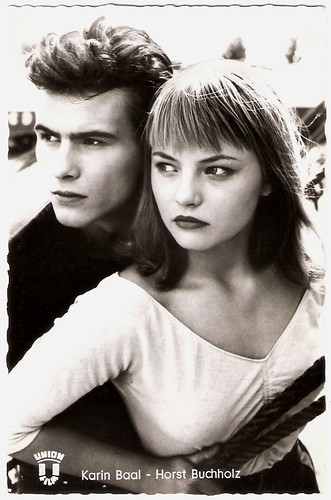
German postcard by Kolibri-Verlag, Minden/Westf., no. 2329. Photo: Interwest / Union / Haenchen. Publicity still for Die Halbstarken (1956).

Austrian postcard by Lichtbild-Vertrieb Paula Weizmann, Wien, no. F 7. Photo: Interwest / Union-Film / Haenchen. Publicity still for Die Halbstarken/Teenage Wolfpack (Georg Tressler, 1956).
Hard, raw and realistic
Young author Will Tremper did not like the sentimental films that were made in Germany and Austria during the 1950s. While German film makers produced cheesy Heimatfilms and family comedies, Hollywood presented energetic teen dramas as The Wild One (Laslo Benedek, 1953) with Marlon Brando, The Blackboard Jungle (Richard Brooks, 1955) and Rebel Without a Cause (Nicholas Ray, 1955), featuring James Dean.
In that vein, Tremper and director Georg Tressler decided to make a film that would become a classic of German post-war cinema.
With the exception of lead actor Horst Buchholz, they chose non-professionals to play the young gang members. Remarkable is also that the jukebox doesn't play the then new and hot rock & roll, but jazz music. Composer Martin Böttcher made the Soundtrack with Mister Martins Band.
The result was a sensation. According to Hal Erickson at AllMovie, the young actors are "exuding a raw energy that many 'pros' could not emulate.
For Volker Scheunert at IMDb, Die Halbstarken/Teenage Wolfpack (Georg Tressler, 1956) is his favourite German film of the 1950s: "This one is hard, raw and realistic, omitting any false sentimentality or romanticism."

Horst Buchholz. German postcard by Kolibri-Verlag, Minden Westf., no. 2171. Photo: Interwest / Union-Film / Haenchen. Publicity still for Die Halbstarken/Teenage Wolfpack (Georg Tressler, 1956).

Karin Baal. German postcard by Kolibri-Verlag, Minden/Westf. Photo: Interwest / Union / Haenchen. Publicity still for Die Halbstarken (1956).
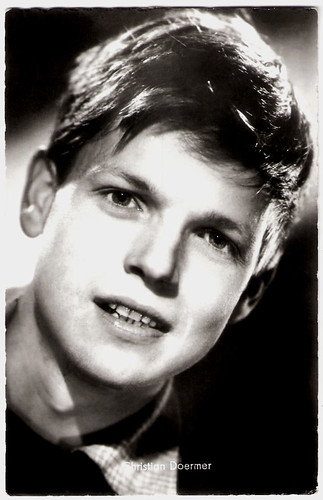
Christian Doermer. German postcard by Kolibri-Verlag, Minden-Westf., no. 140.
Dreaming of a Buick Cabriolet
Die Halbstarken - what can be translated as The Hooligans - was shot on location in West Berlin in 1955 and 1956.
Horst Buchholz plays 19-year old Freddy Borchert, who has been thrown out of his home by his overly strict father (Paul Wagner) and the charismatic but tough teenager has to survive on the streets of West-Berlin.
In an indoor swimming pool he meets his younger brother Jan (Christian Doermer). Freddy pretends to have a good job but he has risen to the head of a youth gang and leads a life of crime.
Jan knows that his parents need the huge sum of 3,000 Deutschmarks to pay their debts, and asks his brother if he could help them. Freddy says yes for his mother’s sake. He is preparing his 'biggest coup' ever: a mail car robbery that would not only allow him to help his parents but to fulfil his dream - buying a Buick Cabriolet.
But the robbery goes wrong. In order to reassert himself as the leader of the pack and to prove to his girlfriend Sissy (Karin Baal) that he is a man, Freddy breaks into the a villa of a wealthy man. Surprised by the owner, the situation escalates.
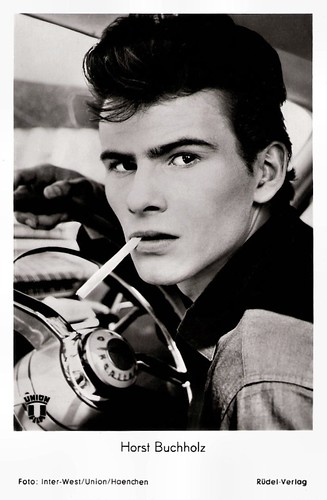
Horst Buchholz. German postcard by Franz-Josef Rüdel, Hamburg-Bergedorf, no. 1858. Photo: Interwest / Union-Film / Haenchen. Publicity still for Die Halbstarken/Teenage Wolfpack (Georg Tressler, 1956).
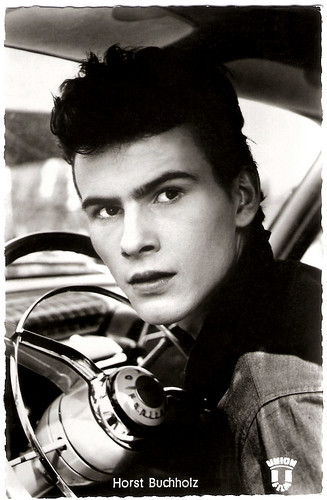
Horst Buchholz. German postcard by Kolibri-Verlag, Minden Westf., no. 2204. Photo: Interwest / Union-Film. Publicity still for Die Halbstarken/Teenage Wolfpack (Georg Tressler, 1956).
A soda-sucking Lolita
At his blog Pause Rewind Obsess, Tim Lucas writes: "in his fourth credited screen appearance, Buchholz actually pulls off something comparable to what John Travolta achieved in Saturday Night Fever. He is positively magnetic in his dramatic scenes, which lets us believe the power he exudes over his mates, but he explodes onscreen - as they say - when he jitterbugs with his girlfriend (future krimi queen Karin Baal) at a local bar."
Karin Baal was chosen out 300 girls, who had joined a talent search for the part. Tim Lucas: "Playing a 15 year old girl, she looks and acts sophisticated beyond her years, but was in fact only 15 (sic, she was 16) in real life; never was she more photogenic or captivating than she is here. A soda-sucking Lolita who matures on our watch into a manipulative, trigger-pulling femme fatale, Baal's Sissy Bohl is an unforgettable character."
For the German release some of the voices of the young and inexperienced performers had been dubbed. Brigitte Grothum for instance dubbed for Karin Baal and Lutz Moik for Kalle Gaffkus.
In 1957 Die Halbstarken could be seen in a dubbed version, titled Teenage Wolfpack - in Britain and the US as well. The tagline was "Think of a law, they've broken it. Think of a crime, they've committed it." The American distributor billed Horst Buchholz as 'Henry Bookholt', and Karin Baal as 'Karen' Baal to help disguise the foreign origin of the film.
Director Georg Tressler was awarded the Filmband in Silber (Silver Filmband) as best new director in 1957. After Die Halbstarken, he made many films and TV productions until the 1990s. Will Tremper continued as a screenwriter and director of nonconformist films. He passed away in 1998.
While Horst Buchholz became an international Star and died in 2003, Karin Baal and Christian Doermer have made their own careers in German Film and Television.
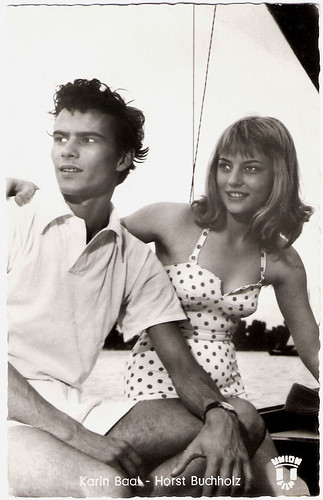
Karin Baal and Horst Buchholz. German postcard by Kolibri-Verlag, Minden/Westf., no. 2202. Photo: Interwest / Union / Haenchen. Publicity still for Die Halbstarken (1956).
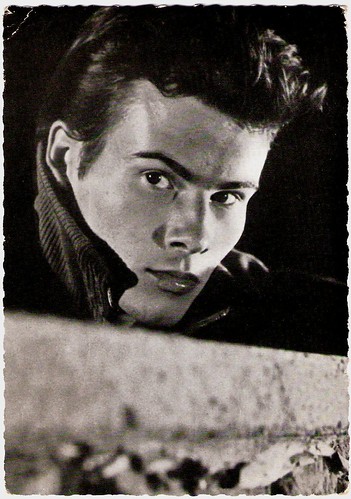
Horst Buchholz. German postcard by Filmbilder-Vertrieb Ernst Freihoff, Essen, no. 140. Photo: Union Film / Kiehl. Publicity still for Die Halbstarken/Teenage Wolfpck (1956).
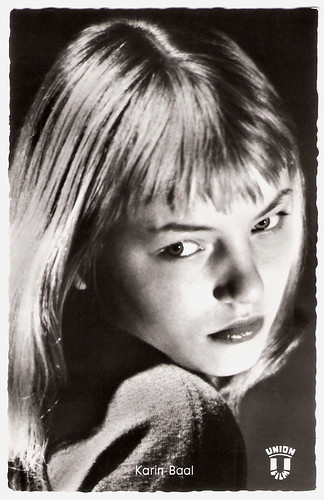
Karin Baal. German postcard by Kolibri-Verlag, Minden/Westf., no. 2096. Photo: Interwest / Union. Publicity still for Die Halbstarken (1956).

Hansjoachim Ketzlin. German postcard by Labaphot. Photo: Interwest / Union / Haenchen. Publicity still for Die Halbstarken (Georg Tressler, 1956). Ketzlin played Willi. During the 1970s, he returned to the cinema as an actor in soft sex films. He also produced three films, including the mediocre thriller Das Amulett des Todes/Cold Blood (Ralf Gregan, Günter Vaessen, 1975) starring Rutger Hauer before his Hollywood breakthrough.
Sources: Volker Scheunert (IMDb), Tim Lucas (Pause Rewind Obsess), Wikipedia (German), Filmportal.de, and IMDb.
I had never heard of this movie, now I want to see it!
ReplyDeleteThanks. In Amsterdam, it was a huge hit among teenagers in the 1956. There were even street fights between the so-called nozems (Dutch greasers) and the pleiners (forrunners of the provos) in front of the cinema Rex at the Nieuwendijk where the film was shown. Dutch youth culture was born.
ReplyDelete